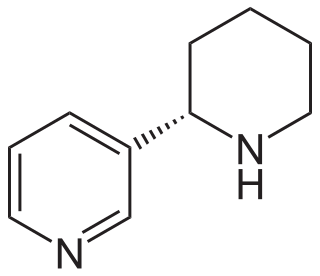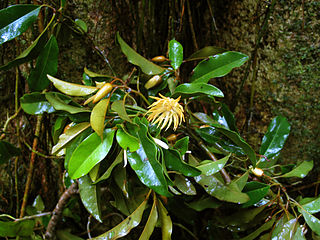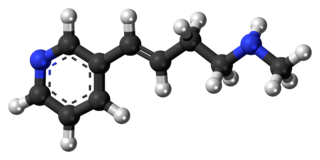History

The earliest record of Aboriginal chewing is found in Joseph Banks's 1770 journal: [2] [4]
We observed that some, though but few, held constantly in their mouths the leaves of an herb which they chewed as a European does tobacco or an East Indian Betel. What sort of plant it was, we had not an opportunity of learning, as we never saw anything but the chaws which they took from their mouths to show us..."
— Joseph Banks, The Endeavour Journal, Volume II, 26 August 1770.
Edmund Kennedy, in his 1847 record of a journey beyond the Barcoo River, described a leaf, tasting strong and hot with the aroma and flavour of tobacco, being chewed by the Aboriginal people. [2] [5] Burke and Wills, on their ill-fated 1861 journey through inland Australia, were given food by local Aboriginal people and also "stuff they call bedgery or pedgery" to chew, which Wills found highly intoxicating even in small amounts. [6] A report from Western Australia described the smoke from burning pituri leaves being used as an anaesthetic during surgical operations such as circumcision. [7]
Other nineteenth century reports said chewing pituri made old men seers, induced valour in warfare and allowed Aboriginal people to walk hundreds of kilometres without food or water; and a 1901 report claimed they "will usually give anything they possess for it". These reports generated significant curiosity within the local scientific community about the identity of the source plant and the identity of pituri's active chemical constituent. [2]
Scientific investigations
In 1872, Joseph Bancroft, a Brisbane physician, received pituri leaves from south-west Queensland, and performed the first pharmacological investigation. The doctor reported that extract of pituri is toxic to frogs, rats, cats and dogs, with a very small dose diluted in water and injected under the skin causing death after respiratory arrest in some cases. [2] [8]
Bancroft received more specimens in 1877, collected on an expedition to north-west Queensland by the explorer William Hodgkinson and identified by Ferdinand von Mueller as the broken leaves and twigs of the shrub Duboisia hopwoodii . Hodgkinson was taken aback by Dr Bancroft's assessment of pituri's toxicity, and said it was as benign as tobacco: [2]
...your remarks as to the toxicological properties of petcherie must I confess astonish me. Sixteen years ago, when with Burke and Wills expedition, subsequently with Mr McKinlay and recently in the north west expedition, I used petcherie habitually when procurable in default of tobacco and have often chewed it both in its raw and prepared state.
— William Hodgkinson quoted by Bancroft, 1877
Bancroft took Hodgkinson's samples to Britain and France where English researchers concluded the plant "is more closely allied to tobacco" and a Parisian chemist identified the active constituent as nicotine. This surprised Bancroft who had compared his extract from the first batch of pituri to nicotine and found the pituri extract to be much more toxic than nicotine, a finding confirmed in 1880 in experiments performed by Liversidge in Sydney on some new Duboisia hopwoodii specimens, and supported by an 1882 report that described Aboriginal hunters in central Australia steeping the leaves of Duboisia hopwoodii in waterholes to stupefy prey that drink the water, and other reports describing cattle, sheep and camels which ate it dying. Yet, when Liversidge sent more samples from yet another batch of Duboisia hopwoodii to England for analysis in 1890 the researchers replied, "there was no obvious difference between its action and that of nicotin[e]."
Research into the identity of pituri's active constituent and its toxicity continued to yield contradictory results over the following decades. [2] [9] [10] [11] [12]
Identifying the plant

Ferdinand von Mueller had identified Bancroft's 1877 batch of pituri as the crushed leaves and twigs of the shrub, Duboisia hopwoodii, and writers subsequently referred to Duboisia hopwoodii as the raw material of pituri. For instance, in his report on the 1891 Elder expedition into northwest South Australia and the Gibson, Great Sandy and Great Victoria deserts of Western Australia, Richard Helms noted, "Whilst these tribes have discovered the stimulating properties of Nicotiana suaveolens [a species of native tobacco], they do not seem to know the more powerful narcotic of 'pituri', Duboisia hopwoodii, which also occurs in many places throughout the same regions." [2] [13]
Then, in 1933 Johnston and Cleland reported that the plant Europeans usually associate with pituri, Duboisia hopwoodii, is not chewed across most of central Australia – native tobacco is; and two years later Hicks and Le Messurier found in a 300-mile radius around the south-west, north-west and north of Alice Springs people "chewed, under the name of 'pituri' the leaves of at least two varieties of Nicotiana ... they wished to indicate that [Duboisia hopwoodii] was 'pituri', but only used when real pituri, i.e. Nicotiana, was unobtainable." [2] [14] [15]
So, it was now clear that pituri is not one substance and the term relates to the chewing of the leaves of various plants including Duboisia hopwoodii and more than one species of native tobacco. [2]
Active constituents
It has long been known that the active constituent in Australia's various Nicotiana species is nicotine. Twentieth century chemical analysis found that both nicotine and nornicotine, a drug four times as toxic as nicotine, are usually present in Duboisia hopwoodii, and the concentrations of these chemicals can vary widely. In one study, specimens of duboisia hopwoodii from Western Australia and western Queensland were found to contain mainly nicotine while the active constituent of South Australian and central Australian Duboisia hopwoodii was predominantly the more toxic nornicotine. These variations may be due to differences in rainfall, harvest season and soil salinity and acidity. [2]
So Bancroft's and Liversidge's unfortunate experimental animals may have been injected with extracts of Duboisia hopwoodii high in the toxic nornicotine, while the specimens they sent to Europe for assessment (collected from different locations at different times) contained the more benign nicotine and little or no nornicotine. The reports of animal poisonings probably relate to the consumption of Duboisia hopwoodii high in nornicotine. Duboisia hopwoodii harvested from around the Mulligan River is high in nicotine and low in nornicotine. [2]
















